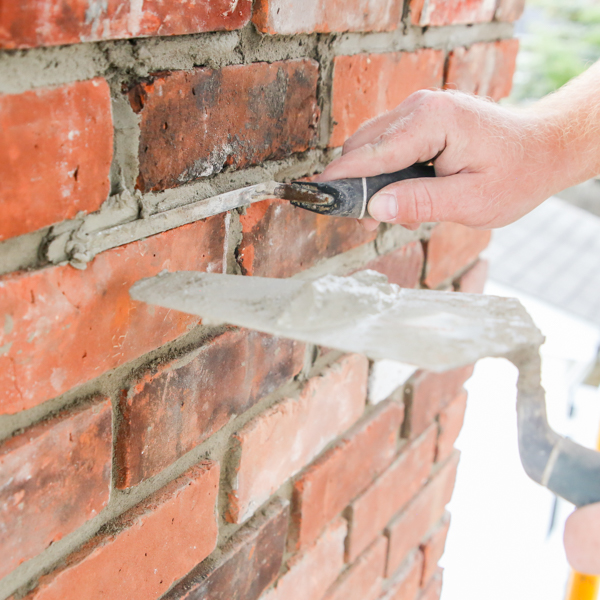Chimney Flashing and Cap Repair: Shield Your Home from Components
Chimney Flashing and Cap Repair: Shield Your Home from Components
Blog Article
Opening the Tricks of Sustainable Stonework Building And Construction Practices for Eco-Friendly Structures
Among the myriad strategies to environmentally friendly structure, sustainable stonework building and construction stands out as a time-tested and long lasting method that holds a wide range of untapped capacity. From the option of materials to ingenious construction techniques, the tricks to accomplishing sustainability within stonework building are diverse and fascinating.
Advantages of Lasting Masonry Building And Construction
Welcoming lasting stonework building and construction practices not just lowers ecological impact but also supplies long-lasting financial benefits to contractors and neighborhoods. By using materials like recycled bricks, blocks, and rocks, building contractors can dramatically lower the carbon footprint of their tasks while promoting source performance. Additionally, sustainable masonry building techniques, such as appropriate insulation and thermal mass residential properties, can improve energy efficiency within structures, resulting in decreased operational prices gradually.
Additionally, the durability and resilience of masonry frameworks add to long-lasting financial benefits. Buildings constructed making use of lasting masonry techniques commonly require less repair and maintenance, translating to cost financial savings for contractors and homeowner. The longevity of stonework products additionally guarantees that frameworks continue to be steady and safe, reducing the requirement for constant remodellings or substitutes.
Eco-Friendly Masonry Materials
Using green stonework products is an essential action in the direction of improving the sustainability of building techniques and lessening environmental impact while optimizing long-lasting economic advantages. Lasting masonry products are sourced, created, and utilized in a way that decreases overall ecological effect. Sustainable concrete obstructs incorporate recycled accumulations and may feature better insulation properties, adding to energy performance in buildings.
Furthermore, all-natural products like adobe, rammed earth, and straw bales supply exceptional thermal mass residential properties, decreasing the demand for heating and cooling down energy. These products are typically locally offered, advertising regional economic situations and minimizing transportation-related carbon emissions. By picking environment-friendly stonework products, building tasks can significantly reduce their environmental impact and contribute to the development of healthier, much more sustainable developed settings.
Energy-Efficient Masonry Strategies
Energy performance plays a critical function in improving the sustainability of masonry building and construction practices. By applying energy-efficient stonework methods, builders can dramatically decrease the overall energy consumption of a building, bring about reduced operational expenses and a smaller sized ecological footprint. One essential energy-efficient stonework method is using thermal mass, which entails including thick products like concrete or block right into the building's structure to take in and keep warm. This assists control interior temperature levels, reducing the requirement for mechanical home heating and cooling down systems.

Advancements in Sustainable Stonework
Recent developments in lasting masonry techniques have produced innovative methods that are improving the building industry. One such technology is the advancement of self-healing concrete, which utilizes germs installed within the concrete to recover cracks autonomously. This breakthrough not only decreases upkeep costs however additionally enhances the longevity of masonry structures, adding to their sustainability.
An additional notable development is the usage of recycled aggregates in masonry building - masonry contractor. By including products such as crushed ceramic waste or recycled glass into concrete mixes, building contractors can decrease the environmental influence of anonymous construction jobs browse this site while preserving architectural honesty. This technique not just draws away waste from landfills but likewise preserves natural deposits, making it an essential development in lasting stonework building and construction
In addition, the integration of digital design tools, such as Building Info Modeling (BIM), is changing the means stonework frameworks are intended and created. BIM permits for even more precise calculations, decreased material waste, and enhanced energy effectiveness, eventually causing more lasting structure techniques. These innovations jointly indicate an encouraging future for lasting masonry building in the era of environment-friendly structures.
Future Trends in Stonework Sustainability
With the ingenious strides made in sustainable stonework methods, the future patterns in masonry sustainability are poised to more reinvent the building and construction market. One of the key fads shaping the future of masonry sustainability is the raised assimilation of innovation. Developments such as Building Details Modeling (BIM) and digital truth simulations are kelly designs in concrete being made use of to optimize masonry building and construction processes, leading to minimized material waste and improved power effectiveness in structures.
Moreover, the development of novel lasting materials is readied to play a considerable function in boosting the eco-friendliness of masonry building and construction. masonry contractor. Advancements like self-healing concrete, recycled aggregates, and bio-based binders are getting traction for their capability to minimize environmental influence while preserving structural honesty

Final Thought
In conclusion, sustainable stonework building and construction methods provide various benefits for environmentally friendly buildings. masonry contractor. Developments in sustainable stonework are constantly being developed to further boost the ecological performance of structures.
Report this page